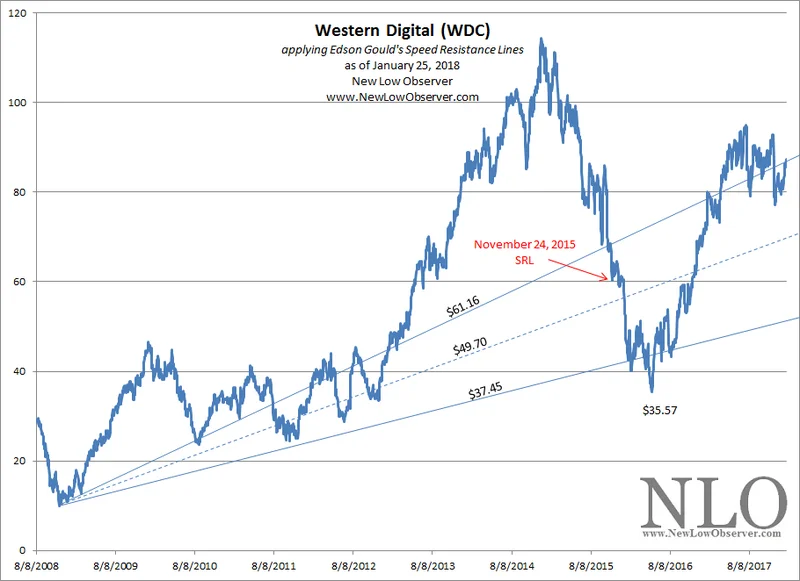I want you to picture two companies standing at the dawn of the AI gold rush. One, NetApp (NTAP), is polished and forward-thinking. It’s selling sophisticated geological mapping software, cloud-based analytics, and intelligent systems to help miners find gold more efficiently. The other, Western Digital (WDC), is a bit grittier. It’s selling pickaxes, shovels, and bigger, stronger wheelbarrows. For the last few years, all the smart money was on the software company. But as the gold rush turned into a frenzy, a funny thing happened. The miners realized they didn't need better maps just yet—they needed to dig, and they needed to haul away mountains of earth, right now.
That, in a nutshell, is the story of what’s happening in the data storage world. Just look at the tale of the tape: over the past year, Western Digital’s stock has skyrocketed an astonishing 116.5%, while NetApp has flatlined, down 1%. When I saw that stock chart, with WDC's line going nearly vertical while NTAP's stayed flat, I honestly had to laugh. It's the kind of market correction that reminds you that fundamentals, the raw physics of a problem, always win in the end. The market has placed a decisive, thunderous bet, and it’s not on the elegant software layer. It’s on the raw, physical, almost brutally simple need for more space.
Why did so many people miss this? For years, the narrative has been about the "intelligent cloud" and the magic of software-defined everything. NetApp is a brilliant company that plays right into that story, offering intelligent data infrastructure and partnerships with giants like NVIDIA. But we got so lost in the abstraction of "the cloud" that we forgot what it’s actually made of: millions of servers humming away in massive buildings, filled with spinning metal platters. Western Digital’s management recently dropped the statistic that should be echoing in every boardroom: nearly 80% of all cloud data is still stored on hard disk drives (HDDs). That’s right, the old workhorse technology. This is the kind of breakthrough that reminds me why I got into this field in the first place—because technology is ultimately about solving real-world physical constraints.
The rise of generative and agentic AI has created a monster with an insatiable appetite for data—unstructured, messy, voluminous data. These models don't just need to be trained on petabytes of information; the applications they power generate tidal waves of new data every second. This isn't a problem you can solve with a clever algorithm alone. You need shelves. Miles and miles of digital shelves. And this is where Western Digital’s strategy suddenly looks less like a legacy holdover and more like a stroke of genius.

They are all-in on making bigger, denser, and more cost-effective HDDs. They’re pushing the boundaries with technologies like ePMR and UltraSMR—which, in simpler terms, are incredibly clever engineering feats to cram more and more data onto the same spinning disk, driving down the total cost of ownership for the hyperscalers who are their biggest customers. While the world was mesmerized by the speed of flash storage, WDC was solving the less glamorous, but far more urgent, problem of sheer capacity. It’s the difference between building a race car and building a supertanker. Right now, the world needs supertankers to move its data.
This strategic focus is now lighting up their financials. As one report put it, Western Digital surges as AI demand fuels Q1 results, guidance; ups dividend (WDC:NASDAQ). The company is forecasting 22% year-over-year revenue growth and watching its gross margins climb from 38.5% to over 41%. They’re paying down debt, buying back stock, and issuing dividends. The market isn't just excited; it’s rewarding a company that delivered the exact right tool at the exact right moment. But this explosive growth begs a serious question: as we build out this colossal physical infrastructure to power our digital world, are we fully prepared for the energy and environmental costs that come with it? The demand is undeniable, but the responsibility is immense.
NetApp, on the other hand, finds itself in a trickier position. Its tools are arguably more advanced, focusing on managing complex workloads across hybrid clouds and optimizing data for AI. They’ve secured over 125 AI deals and are deeply integrated into the ecosystem. And yet, the company speaks of "macro-driven spending caution" and delivered just 1% revenue growth. What does this tell us? It suggests that while companies know they need AI, their first, most desperate priority is simply finding a place to put all the data. The optimization and intelligent management can come later. First, you dig.
So, what’s the real story here? It’s a powerful reminder that for all our talk of the ethereal, weightless digital world, it is built on a foundation of atoms. Silicon, metal, and plastic, housed in buildings that consume staggering amounts of electricity. Western Digital’s spectacular rise isn’t just a victory for one company’s stock; it’s a reality check for the entire tech industry. We’ve been so focused on the intelligence layer—the "mind" of AI—that we underestimated the needs of its body. Right now, that body is growing at a pace we can barely comprehend, and it needs raw, physical space more than anything else. WDC bet on the shovel, and in this phase of the gold rush, the shovel is king.